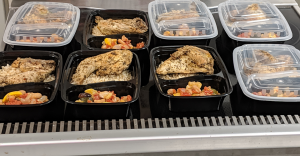VIDEO: Tips for Managing Parkinson’s During Mealtime

Back to physical health resource hub
Video Transcript
Hi, my name is Amy Jo Rohe and I’m an occupational therapist at Brooks Rehabilitation.
According to the Parkinson’s Disease Foundation approximately 60,000 Americans are diagnosed with Parkinson’s disease each year.
In this series, I am going to share strategies for managing symptoms of Parkinson’s.
Mealtime is a common time for symptoms of Parkinson’s disease to interfere with function.
Today, I’m going to show you some tools and strategies to help manage symptoms while eating and drinking.
Weighted utensils are helpful for stabilizing your hand if tremors are interfering with your ability to use your utensils while eating. These are basically utensils that are heavier than regular utensils. There are many different types available.
This one has a thick rubber handle. However, weighted utensils that look more like regular silverware are also available.
If you type weighted utensils into a search engine you will see many different options available for purchase.
If your tremor is more significant there are higher tech options available that electronically level or steady the spoon as you move it. This is an example of an electronic leveling spoon. As you can see, no matter how I move my hand, the spoon stays upright. There are other options available that are specifically designed for tremors.
If you type steadying spoon into a search engine, you will see many different options available for purchase.
If you are prone to spilling beverages consider using a travel mug or a water bottle with the built-in straw. These will help you drink your beverages without having to worry about spilling.
If you have difficulty loading your food onto your utensil while eating, you can use a section plate that has a high rim around the outside that you can use as a back board while you’re scooping food onto your fork. As another option, consider using a bowl instead.
Thank you for watching.
For additional tips and strategies tailored to your unique situation, be sure to talk to your occupational therapist.
For more healthy living tips, visit our YouTube Playlist.


